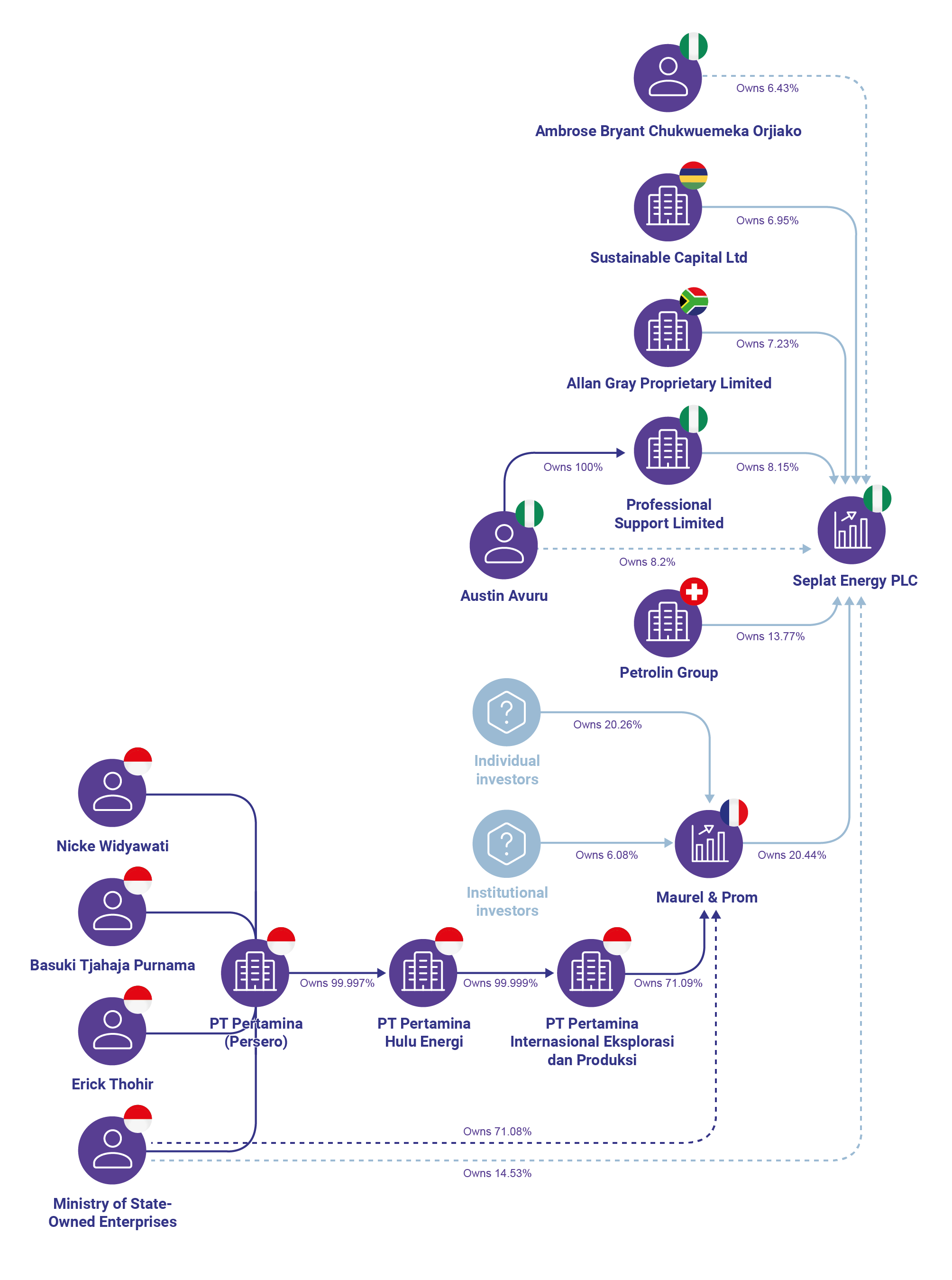Defining and capturing data on the ownership and control of state-owned enterprises
Capturing structured data
A fuller picture of the ownership and control of Pertamina using structured data

The Pertamina example used throughout this document, and seen in full in the diagram above, shows how complex SOEs can be. The information above follows only one track of a subsidiary out of over 100 direct and indirect subsidiaries and associates spanning the globe. [21]
Substantial time was needed to compile this limited data from public sources, including websites, reports and government registers. The collection and publication of this information in structured data formats, such as BODS, would make these types of tasks more accessible.
Publishing this information as structured data [22] would also better support and allow for the kind of analysis and visualisation carried out above. Keeping this information more up to date and auditable so as to “identify any changes in state ownership of interests in extractive companies” within a given year will make records easier to check; [23] satisfy international standards for timeliness; [24] and help satisfy Requirement 2.6 of the EITI Standard.
Based on EITI assessment criteria, [25] Open Ownership recommendations [26] and research conducted to explore the examples used in this guidance, governments should consider capturing detailed information on all of the following to fully understand the ownership or control of SOEs:
- The SOE
- The state’s role or interests in the SOE
- The state body or bodies which own or control the SOE, or the state itself where the details of the state body are not available
- Beneficial owners of the SOE
- Joint ventures
- Information gaps in disclosures
These echo and reinforce related recommendations from the OECD, [27] the Natural Resource Governance Institute (NRGI) [28] and a coalition of transparency advocacy groups. [29] Full field details for these areas can be found in Appendix A.
For ease of collection and use, consideration should be given to collecting, storing and publishing this information in a structured data format, such as BODS.
Good practice case study
An example of a country having good rules in place for capturing beneficial ownership information for SOEs is Ghana, which has implemented a 5% ownership or control threshold for the reporting of beneficial ownership information in the extractive sector, due to it being high risk. The country has no threshold for local PEPs and a 5% threshold for foreign PEPs. Information on natural persons, publicly listed companies and SOEs is gathered via dedicated forms, although there are potential improvements that could be made to these forms in order to enable the capturing of complex ownership or control structures involving multiple officials. In addition, information is not yet made available to the public as structured data. A small fee is payable to receive information on individual companies as a PDF.
Endnotes
[21] OECD (n.d.), Pertamina, Excel spreadsheet. Retrieved from https://www.oecd.org/dev/Pertamina.xlsm.
[22] Kiepe, T. and Lord, J. (2022, 12 August), Structured and interoperable beneficial ownership data. Open Ownership. Retrieved from https://www.openownership.org/en/publications/structured-and-interoperable-beneficial-ownership-data/.
[23] Armstrong, K. (2022, 22 August), Building an auditable record of beneficial ownership. Open Ownership. Retrieved from https://www.openownership.org/en/publications/building-an-auditable-record-of-beneficial-ownership/.
[24] FATF (2022), Public Statement on revisions to R.24. Retrieved from https://www.fatf-gafi.org/publications/fatfrecommendations/documents/r24-statement-march-2022.html.
[25] EITI, EITI Requirement 2.6 – State participation and state-owned enterprises: Guidance Note, 9.
[26] Open Ownership (n.d.), Representing state-owned enterprises (Beneficial Ownership Data Standard technical guidance). Retrieved from https://standard.openownership.org/en/0.3.0/schema/guidance/repr-state-owned-enterprises.html.
[27] OECD (2019), Guidelines on Anti-corruption and Integrity in State-Owned Enterprises. Retrieved from www.oecd.org/corporate/Anti-Corruption-Integrity-Guidelines-for-SOEs.htm.
[28] Anticorruption Guidance for Partners of State-Owned Enterprises (n.d.), Anticorruption recommendations for state-owned enterprises, NRGI, 3. Retrieved from https://soe-anticorruption.resourcegovernance.org/files/rec-SOEs-anticorruption-recommendations-for-SOEs.pdf.
[29] NRGI (2021, 14 October), Democratizing the Benefits of Natural Resources: Anticorruption and Public Accountability in the Extractive Sector and Energy Transition. Retrieved from https://resourcegovernance.org/blog/democratizing-benefits-natural-resources-anticorruption-public-accountability-extractive-summit-democracy.